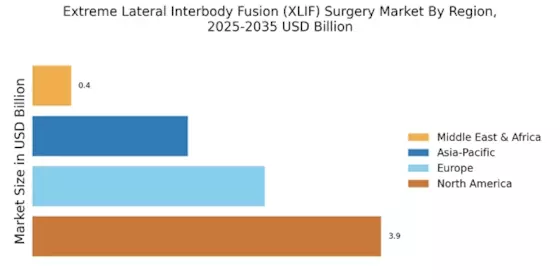Rising Incidence of Spinal Disorders
The increasing prevalence of spinal disorders, such as degenerative disc disease and spinal stenosis, is a primary driver for the Extreme Lateral Interbody Fusion (XLIF) Surgery Market. As populations age, the incidence of these conditions rises, leading to a greater demand for effective surgical interventions. According to recent data, spinal disorders affect millions worldwide, prompting healthcare systems to seek innovative solutions. The XLIF technique, known for its minimally invasive nature, offers patients reduced recovery times and improved outcomes. This growing patient population necessitates advancements in surgical techniques, thereby propelling the XLIF market forward. Furthermore, as more patients become aware of their treatment options, the demand for XLIF procedures is likely to increase, further solidifying its position in the surgical landscape.
Increased Investment in Spine Surgery
Increased investment in spine surgery is a notable driver for the Extreme Lateral Interbody Fusion (XLIF) Surgery Market. Healthcare providers are recognizing the importance of spinal health and are allocating more resources towards advanced surgical techniques. This trend is reflected in the growing number of specialized spine centers and the expansion of existing facilities to accommodate more complex procedures. Financial backing for research and development in spinal surgery technologies is also on the rise, leading to improved surgical methods and patient outcomes. As investments continue to flow into the spine surgery sector, the XLIF technique is likely to benefit from enhanced training programs and better surgical tools, further solidifying its role in modern spinal care.
Rising Patient Awareness and Education
Rising patient awareness and education regarding spinal health and treatment options are driving the Extreme Lateral Interbody Fusion (XLIF) Surgery Market. As patients become more informed about their conditions and the available surgical interventions, they are more likely to seek out advanced procedures like XLIF. Educational initiatives by healthcare providers and advocacy groups have played a crucial role in disseminating information about the benefits of XLIF, including its minimally invasive nature and quicker recovery times. This increased awareness is leading to higher patient demand for XLIF surgeries, as individuals actively seek out the best treatment options for their spinal disorders. Consequently, healthcare providers are responding to this demand by expanding their offerings of XLIF procedures, thereby contributing to the growth of the market.
Technological Innovations in Surgical Techniques
Technological advancements in surgical techniques are significantly influencing the Extreme Lateral Interbody Fusion (XLIF) Surgery Market. Innovations such as enhanced imaging systems, robotic-assisted surgery, and improved instrumentation have transformed the way spinal surgeries are performed. These technologies not only enhance precision but also reduce the risk of complications, making XLIF a more attractive option for both surgeons and patients. The integration of advanced technologies has been shown to improve surgical outcomes, which is crucial in a competitive healthcare environment. As hospitals and surgical centers invest in state-of-the-art equipment, the adoption of XLIF procedures is expected to rise. This trend indicates a shift towards more sophisticated surgical methods, which could potentially reshape the future of spinal surgery.
Growing Preference for Minimally Invasive Surgery
The growing preference for minimally invasive surgical techniques is a significant driver of the Extreme Lateral Interbody Fusion (XLIF) Surgery Market. Patients increasingly favor procedures that promise shorter recovery times, less postoperative pain, and minimal scarring. XLIF, being a minimally invasive approach, aligns perfectly with these patient expectations. Data suggests that minimally invasive surgeries have seen a surge in adoption, with many healthcare providers prioritizing these techniques to enhance patient satisfaction. As more surgeons become trained in XLIF methods, the procedure's popularity is likely to grow. This shift towards minimally invasive options not only benefits patients but also encourages healthcare facilities to adopt XLIF as a standard practice, thereby expanding its market reach.


















Leave a Comment